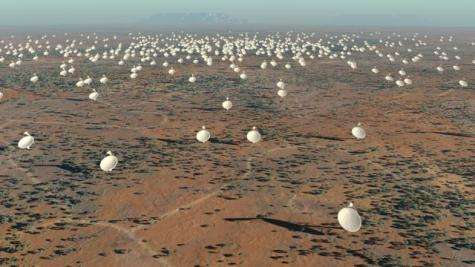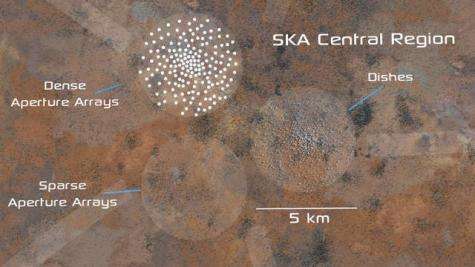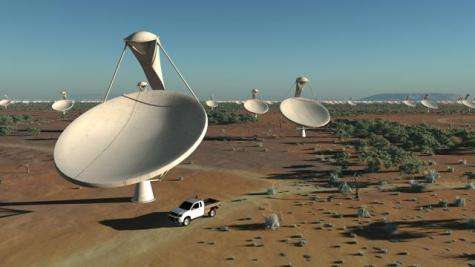April 1, 2011 report
Group sets plans for largest radio telescope ever

(PhysOrg.com) -- Proving that a lot of little things can go a long way, a group of astronomers have revealed plans to build and install a radio telescope array out of thousands of small inexpensive dishes, spread out over thousands of miles of remote territory.
Known as the Square Kilometer Array (SKA) the telescope would be the largest of its kind ever created, and would give scientists clues about the creation of the universe, help understand dark matter, or even maybe, perhaps, help receive signals from other intelligent life forms.
The SKA, so named because of the collective size of the dishes that would make up the system, would be comprised of over 3000 relatively inexpensive dishes that when connected together, and coordinated with a new, as yet undeveloped supercomputer, would result in a single radio telescope capable of delivering 50 times greater sensitivity than anything currently operating. And if that’s not enough, it would also provide 100 times the resolution.
The group, comprised of scientists from over twenty countries, expect costs to be in the neighborhood of $2 billion, with construction starting sometime in the next decade and completion in 2024.
A site for the proposed telescope has not yet been chosen, though several countries are vying for selection and the scientific prominence and influx of international cash that would result. The problem is, there are few optimal sites, due to the fact that all of the dishes would have to be situated in a place so remote that no people, cars, phones or other noise making devices would be in the vicinity. Currently, the leading contenders appear to be a block of countries in southern African and Australian and New Zealand.

The telescope would in actuality be comprised of both conventional dish receivers and flat plates that that can be controlled electronically to listen and point to different parts of the spectrum.

Adding to the cost and complexity of the project would be the actual connecting together of the individual parts, likely with fiber optics and a controller that would have to not only position the nodes on the network, but would have to account for time lags as well, and as much as 20 GB of data per second from each of the telescopes.
Like the Large Hadron Collider project, most of those involved in the SKA project expect that if it’s completed as hoped, new discoveries will be made with it that no one as yet can possibly imagine.
More information: www.skatelescope.org/
© 2010 PhysOrg.com


















